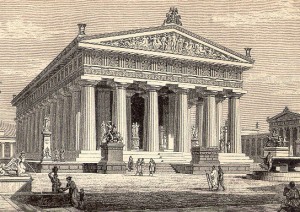It was around 600 BC that Greeks from Sybaris founded the city named Poseidonia, from the name of Poseidon, the god of the sea.
In the 7th century BC, Strabon evoked a fortified installation bearing this name. It is likely that the first settlements were further west, at the mouth of the Silaros.
The city enjoyed its golden age during the 6th and 5th centuries BC. Next to its sea and river port, its sanctuary became one of the largest and most venerated of the Italian peninsula.
From about 420 to 273 BC, Poseidonia was occupied by an Italic people, the Lucanians, who baptized the city Paiston. We do not know on what occasion they ousted the Greeks.
In 273 BC, it became a Roman colony, under the name of Paestum.
The city began to decline in the fourth century AD, and the situation worsened with the fall of the Roman Empire. The territory became unhealthy because of poor drainage and experienced a malaria epidemic around the year 500.
The inhabitants gradually abandoned the city, and moved to Capaccio. The marshy site of Paestum remained abandoned until it was rediscovered in the 18th century with the fashion of the “grand tour” and the travels of rich European youth.
History of Paestum
- Introduction
- Prehistory and foundation of Poseidonia
- Greek and Lucanian period
- The Roman Paestum
- From the decline of Paestum to its rediscovery


